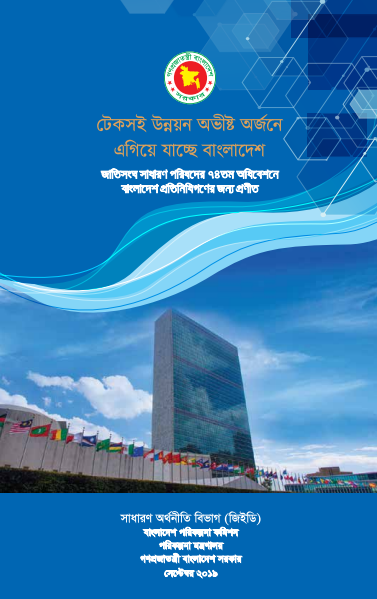টেকসই উন্নয়ন অভীষ্ট (এসডিজি) বাস্তবায়নের পথে বাংলােেশর সর্বশেষ অর্জনসমূহ সংক্ষিপ্তাকারে তুলে ধরার জন্য এই পুস্তিকাটি প্রণীত হয়েছে। বাংলাশে ইতোমধ্যে কিছু কিছু ক্ষেত্রে ২০২০ সালের লক্ষ্যমাত্রা অর্জন করেছে, কিছু সূচকের অগ্রগতি ২০২০ সালের লক্ষ্যমাত্রা অর্জনে সঠিক পথে রয়েছে। আবার কিছুসংখ্যক সূচকের অগ্রগতি কাঙ্খিতমাত্রায় আনয়নের েিক বিশেষ নজর েিত হবে। এসডিজির ২৩২টি সূচকের মধ্যে েেশ এ যাবৎ প্রাপ্ত ৮৩টি সূচকের উপাত্ত বিশ্লেষণ করে এই পুস্তিকাটি প্রণয়ন করা হয়েছে। তবে এসডিজি বাস্তবায়ন অগ্রগতি পর্যালোচনার ক্ষেত্রে, বিশেষ করে অভীষ্ট ১১, ১২, ১৩, ১৪ এবং ১৫ এর সূচকগুলোর অগ্রগতি পর্যালোচনার ক্ষেত্রে উপাত্তের অভাব এখনো একটি বিরাট চ্যালেঞ্জ।‘সমাজের সবাইকে নিয়ে’ এগিয়ে যাওয়ার টেকসই উন্নয়ন র্শনকে ধারণ করে বাংলাশে সরকার এসডিজি’র প্রতিটি অভীষ্ট বাস্তবায়নের লক্ষ্যে সুস্পষ্ট পথনির্শেনা প্রানের প্রয়োজনীয় পক্ষেপ গ্রহণ করেছে।আমি প্রত্যাশা করি জাতিসংঘের সাধারণ পরিষরে ৭৪তম অধিবেশনে যোগানকারী বাংলাশে প্রতিনিধিলের জন্য এই লিলটি সহায়ক হবে, বাংলােেশর এসডিজি অর্জনে অগ্রগতি বিষয়ে সম্যক ধারণা। এসডিজি’র এজেন্ডাসমূহ সম্পূর্ণরূপে বাস্তবায়নের জন্য প্রয়োজনীয় অর্থায়ন পর্যালোচনার পাশাপাশি এ যাবৎ প্রাপ্ত বৈিেশক সহায়তার পরিমাণও বিশ্লেষণ করা হয়েছে।
Found 160 Results From
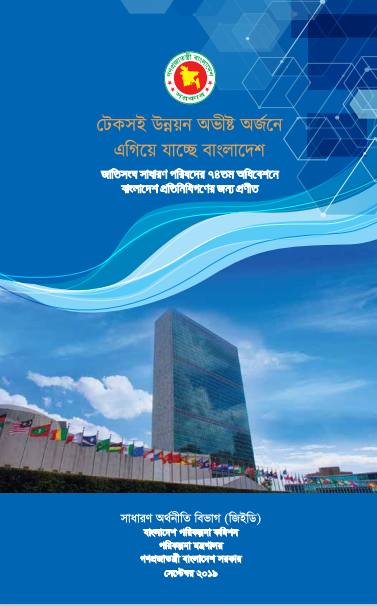
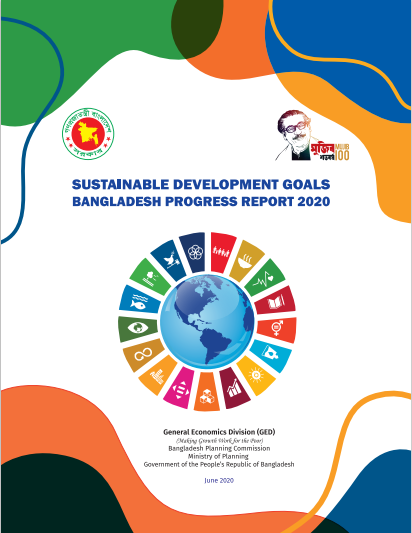
Sustainable Development Goals Bangladesh Progress Report 2020
 February 18, 2021
February 18, 2021 The ‘Bangladesh SDGs Progress Report 2020’ prepares the ground in the lead up to 2019, highlighting how much more effort will be needed to reach the SDGs and meet the commitment to leave no one behind. The preparation process of the Report replicates the similar methodology as adopted in preparing the Bangladesh’s first SDGs Progress Report in 2018. The year 2020 is a critical juncture to reflect on the first four years of the Agenda 2030 implementation and to allow for adjustments to priorities and course corrections. For Bangladesh, it represents a key window of opportunity to inject urgency and catalyse updated or new commitments from all stakeholders – all of which will be necessary if leave no one behind goal and Agenda 2030 are to be achieved.
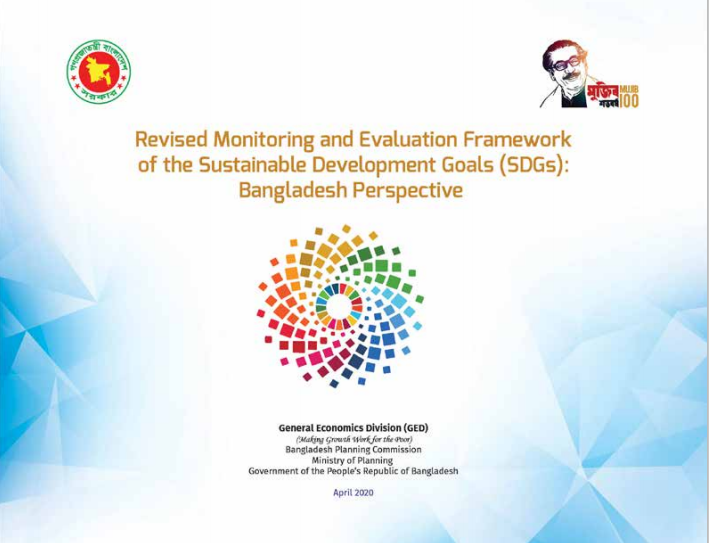
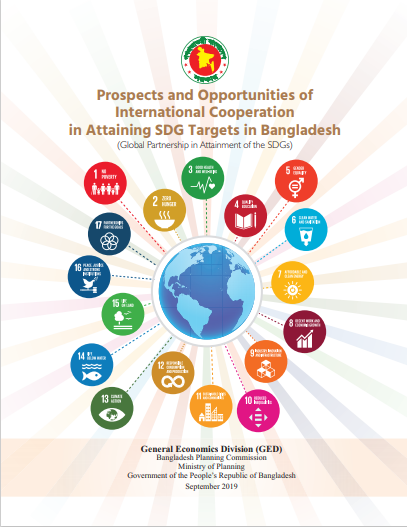
Prospects and Opportunities of International Co-operation in Attaining SDG target in Bangladesh
 February 18, 2021
February 18, 2021 The United Nations (UN) Member States formally adopted the Sustainable Development Goals (SDGs) agenda on 25 September 2015. The 17 SDGs, and its associated 169 targets with 232 indicators, aim to end poverty, hunger and inequality; act on climate change and the environment; improve access to health and education; care for people and the planet; and build strong institutions and partnerships.
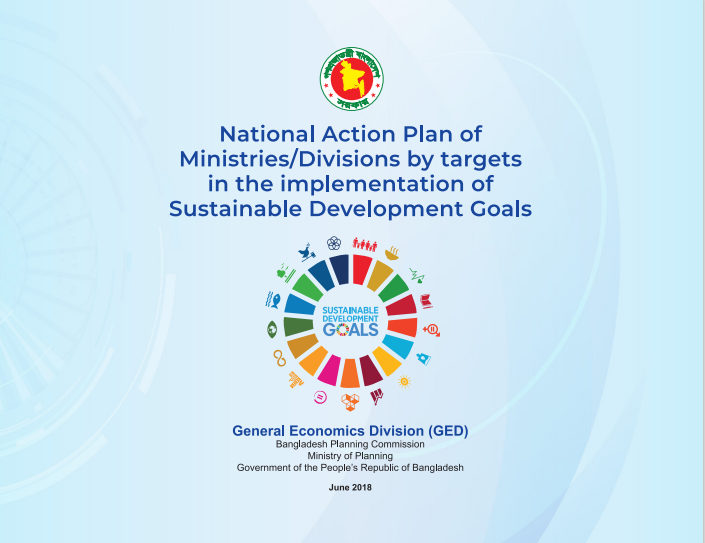
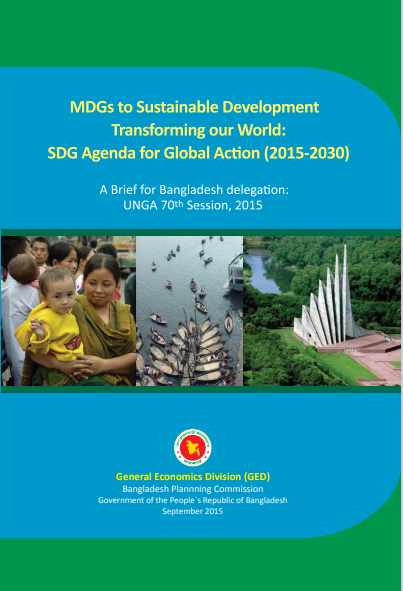
MDGs to Sustainable Development Transforming our World:SDG agenda for Global Action (2015-2030)
 February 18, 2021
February 18, 2021 This booklet on Bangladesh's MDGs achievements and the process of formulation of Post2015 Development Agenda was prepared with the aim to be used by Bangladesh Delegation led by Hon'ble Prime Minister Sheikh Hasina in the 70th UNGA to be held from 15-30 September 2015 in New York, USA.
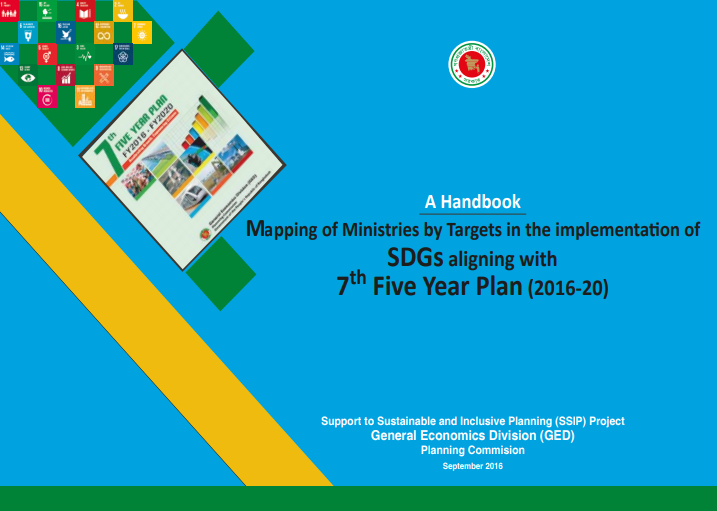
Mapping of Ministries by Targets in the implementation of SDGs aligning with 7th Five Year Plan (2016-20)
 February 18, 2021
February 18, 2021 The inputs for the SDGs’ targets as per 7th Five Year Plan were compiled and analysed to prepare the Handbook by a team led by Mr. Mohd. Monirul Islam, Deputy Chief, GED; other members of the team were Mr. Md. Mahbubul Alam Siddiquee, SAC; Ms. Kohinoor Akter, AC; Syed Ali Bin Hassan, AC; Mr. Shimul Sen, AC; and Ms. Josefa Yesmin, AC of GED. The team had taken the ‘Allocation of Business’ in account to identify the respective Lead and Co-Lead Ministries/Divisions for each of the 169 Targets of SDGs.
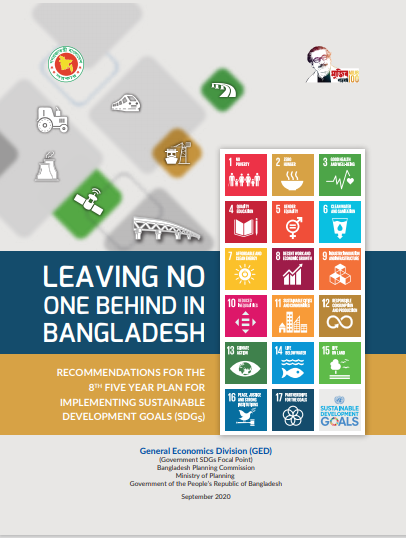
Leaving No One Behind (LNOB) Study
 February 18, 2021
February 18, 2021 Bangladesh has made remarkable progress in terms of institutionalising the SDGs implementation mechanism and developing the integrated policy framework for Agenda 2030. For achieving Vision 2041 and emerging as a high income country by 2041, the country is currently preparing the Perspective Plan 2021-2041 and the 8th Five Year Plan (2021-2025) that aim to ‘leave no one behind’ (LNOB) and promote equitable and inclusive growth and development
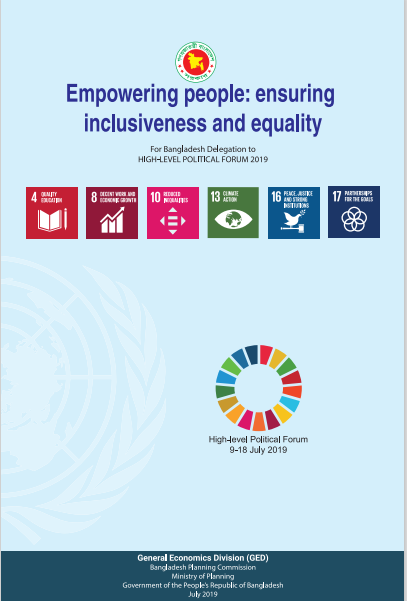
Empowering people: ensuring inclusiveness and equality
 February 18, 2021
February 18, 2021 The government of Bangladesh endorses the notion of citizens’ empowerment as the creation of economic opportunity, the ability to freely choose one’s own path of profession in life in accordance with one’s distinctive talents and abilities.
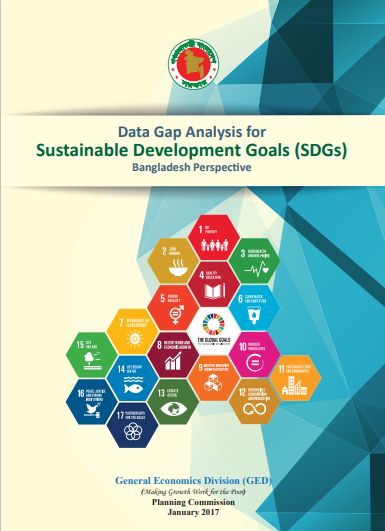
Data Gap Analysis for Sustainable Development Goals (SDGs) Bangladesh Perspective
 February 18, 2021
February 18, 2021 A format for Data Gap Analysis was primarily developed at the Poverty Analysis and Monitoring (PA&M) Wing of General Economics Division (GED) following the format of Mapping of Ministries/Divisions by Sustainable Development Goals (SDGs) targets and indicators.
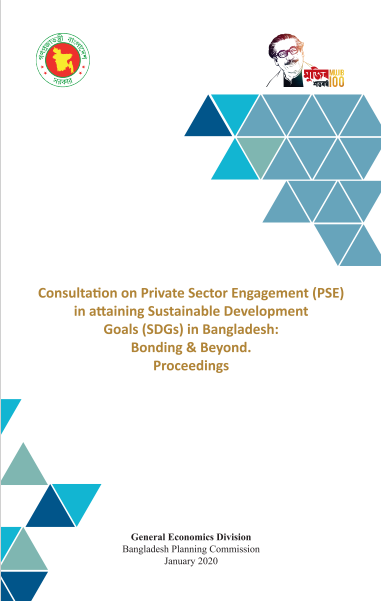
Consultation of Private Sector Engagement (PSE) in attaining Sustainable Goals-2020
 February 18, 2021
February 18, 2021 Private Sector Engagement in attaining Sustainable Development Goals (SDGs) in Bangladesh: Bonding & Beyond” was the third in the series of private sector consultations on SDGs organized by the General Economics Division (GED), Bangladesh Planning Commission, Ministry of Planning. The consultation was organized in cooperation with the Engaging with Institutions (EI) IP project of UNDP Bangladesh.
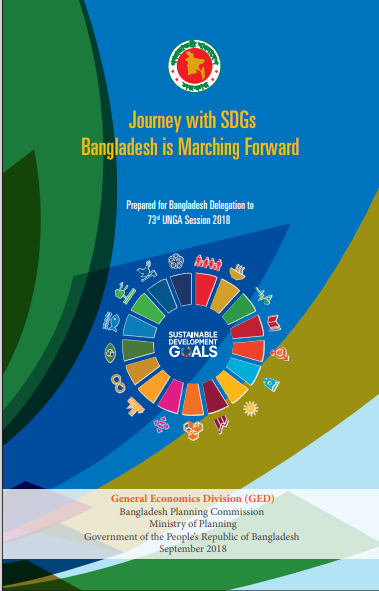
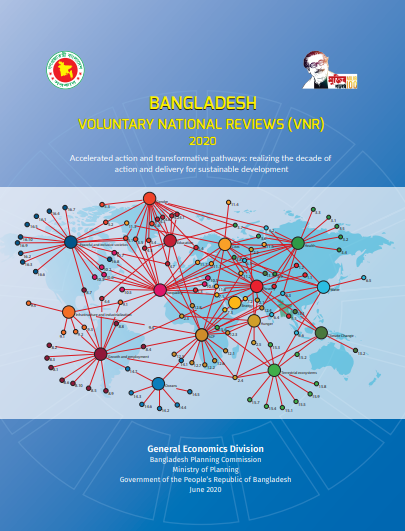
Bangladesh Voluntary National Reviews (VNR) 2020
 February 18, 2021
February 18, 2021 In the last decade, Bangladesh has greatly been benefitted from the visionary and dynamic leadership of the Hon’ble Prime Minister Sheikh Hasina and the way she adopted people-centred approach for the country’s development agenda. As a result, Bangladesh has achieved the highest cumulative GDP growth globally in the last ten years and made remarkable progress in various social and economic spheres and is now being recognized as the ‘development surprise’ or ‘role model of development’. The continuity in office through people’s mandate since 2009 has helped to undertake many initiatives, which resulted in building a happy, prosperous democratic country based on equality and justice.
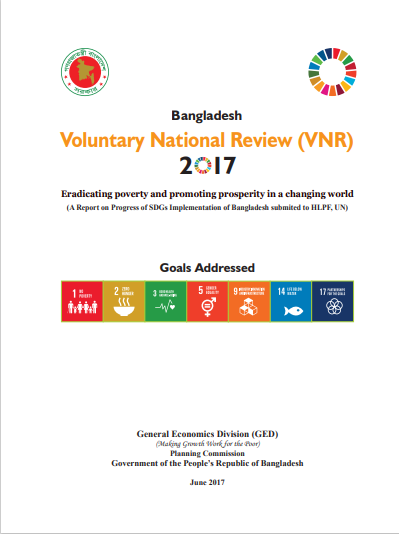
Bangladesh Voluntary National Review (VNR) 2017
 February 18, 2021
February 18, 2021 Bangladesh, as part of her commitment to implement the Sustainable Development Goals (SDGs), decided to take part in the Voluntary National Review (VNR) at the UN High Level Political Forum (HLPF). We have an inspiring story to tell. We have earned many international accolades for our achievements in Millennium Development Goals (MDGs).
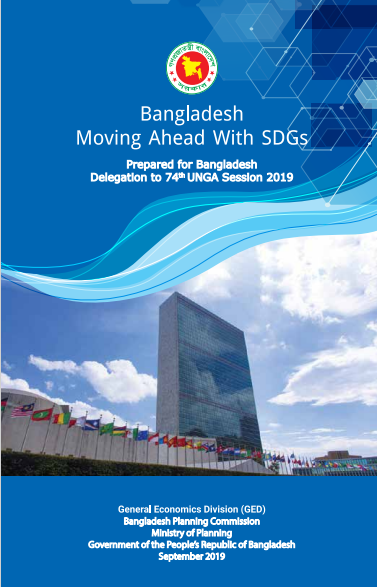
Bangladesh Moving Ahead with SDGs 74th UNGA Session
 February 18, 2021
February 18, 2021 This booklet is prepared providing a broad picture scenario on the assessment of progress made under each goal in implementation of SDGs in Bangladesh. Bangladesh has already met some of the targets set for 2020 that is noteworthy, while some indicators are on track towards meeting the target of 2020. However, there are a number of indicators those need special attention in order to move the trajectory on track. This booklet has been prepared analyzing data of 83 indicators currently available in the country. However, dearth of data has still been an emerging challenge, particularly for the indicators of SDG 11, 12, 13, 14 and 15, for monitoring the progress of attainment of SDGs in the country
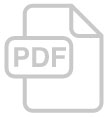
Strategies for a paradigm shift in agriculture, aquaculture, animal husbandry and forestry for food security and nutrition in Bangladesh
 February 18, 2021
February 18, 2021 The overall objectives of the study is to focus on emerging issues and challenges in Bangladesh agriculture in the context of the national objective of ensuring food security and adequate nutrition standards over the next decades.
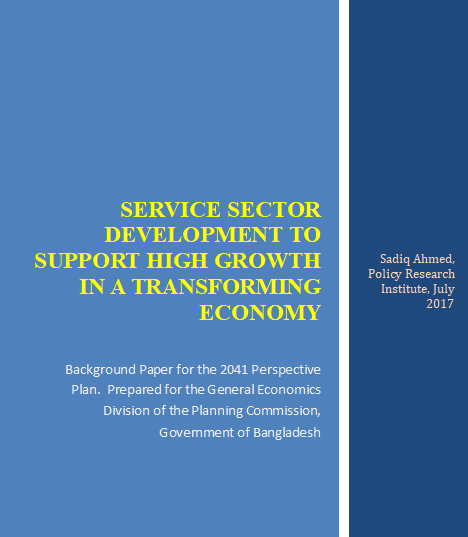
Services Sector Strategy for a Transforming Economy
 February 18, 2021
February 18, 2021 The services sector is an integral part of the Bangladeshi economy. It provides a convenient bridge for the transformation of the rural agrarian economy to a primarily urban industrial economy. In a typical transformation path, as the agriculture sector modernizes, labor transits initially from agriculture to mainly low-skill rural and urban services. These services, mostly informal in nature, provide a cushion for labor absorption as agricultural employment shrinks. The labor thus released from agriculture eventually either retrains and gets distributed to manufacturing and modern services, or stays put in informal services. The growth of services activities and employment is primarily a function of demand. In today’s global world where labor and capital are mobile, both domestic demand and world demand matters for the expansion of the services sector.
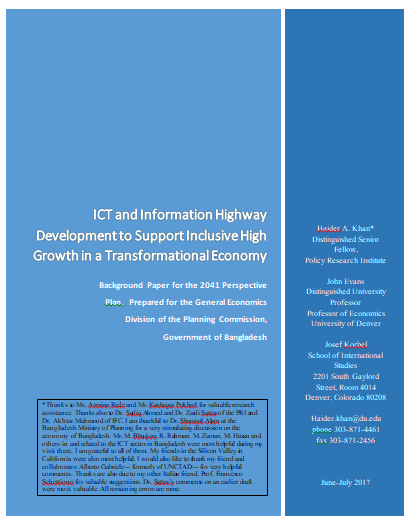
Science, Technology & ICT
 February 18, 2021
February 18, 2021 Since its liberation after a bloody war against the Pakistani military dictatorship, Bangladesh has gone through many ups and downs but particularly since the late 1990s the country has shown great promise by pushing ahead with its development agenda vigorously. Poverty has declined rapidly and economic growth is showing an upward trend reaching between 6 and 7 percent per annum in the second decade of this century. It is realistic to expect a growth rate of 8 percent. However, technological progress and innovation, especially in the ICT sector will be crucial in achieving rapid inclusive growth.

Reducing Cost of Doing Business to Spur Domestic and Foreign investment September 30, 2017
 February 18, 2021
February 18, 2021 Bangladesh has been on a transformation path with the manufacturing sector driving exports and job growth resulting in sustained robust average growth in both GDP and in per capita GDP, facilitated by some conducive policy reforms. From here on, the prospects of rapid growth with extensive job creation requires a high-performing and diversified manufacturing sector which will remain, for some time to come, the main driver of growth in Bangladesh.



